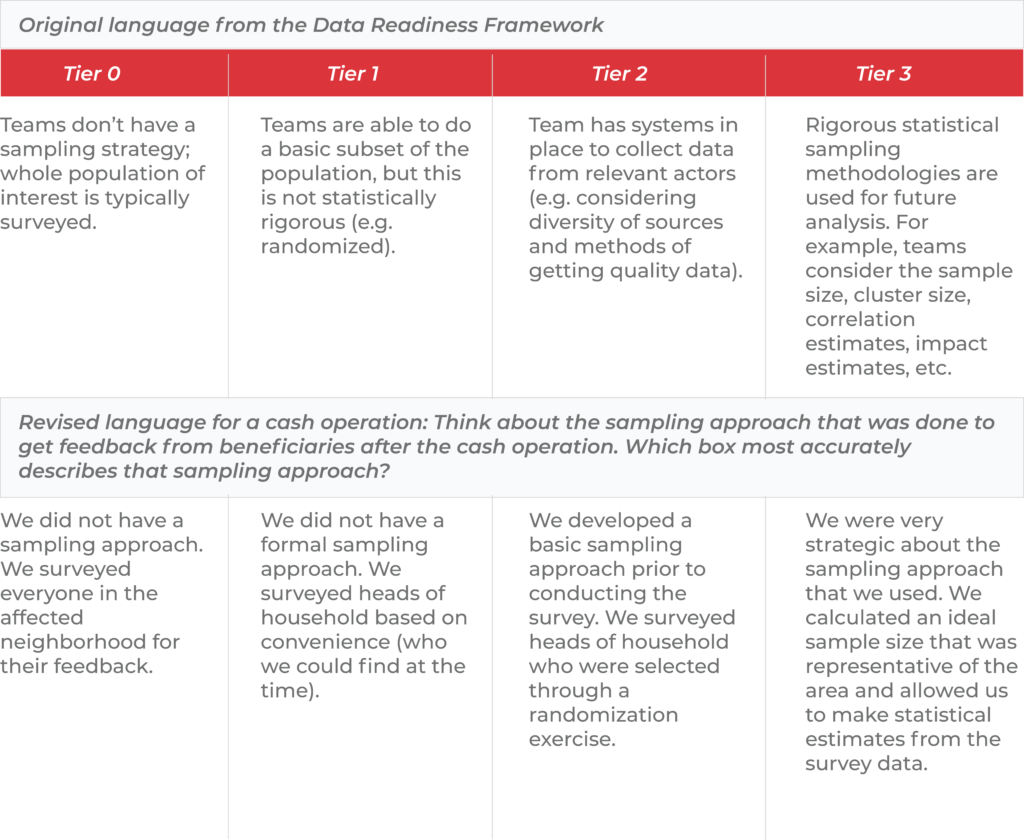Data Readiness Toolkit
Introduction
An overview of data readiness
In the Red Cross Red and Crescent Movement context, data readiness is the ability of National Societies to use quality and timely information in humanitarian operations and programs. This toolkit provides some guidance on how National Societies can improve data readiness for humanitarian operations and programs, structured around the Data Readiness Theory of Change.
You will also find examples of creative ways that National Societies have applied this guidance and learn how it impacted their organizational data readiness.
Do you want to share your National Society’s experience with data readiness? Email katherine.lilly@redcross.org!
Intro video
Why does data readiness matter?
The IFRC and National Societies are thinking critically about how to become more data ready. Improving staff and volunteers’ skills with and understanding of data will equip National Societies to respond to, recover from, and prepare for disasters more effectively.
Click the links below to learn more about how data readiness has been applied in National Societies and projects:
How to get there
There are many paths to becoming a data ready organization. This toolkit outlines an easy-to-follow roadmap to data readiness. Whether you are learning about data readiness for the first time, developing a strategy for your team, or putting together a project proposal, follow the steps below and get started!
Data readiness one-pager
Need a short one-pager on the roadmap to data readiness? Print this.
Learn the basics
What should be considered when we talk about data readiness?
Data readiness is comprised of three main components: 1) data literacy, 2) data preparedness, and data-driven decision making. Keep reading to learn more about each of these components.
Theory of change
All the components and related competencies are part of a broader Theory of Change (ToC) on data readiness for operations and programs. If you're interested, go ahead and review the ToC. You can use it as a reference for learning more about data readiness, strategy development, project proposals, or other data needs.
Assess your priorities
DATA READINESS FRAMEWORK
The Data Readiness Framework describes the competencies related to data literacy, data preparedness, and data-driven decision making. It uses a four-tiered system to help National Societies understand where their current data readiness competencies, gaps, and priorities are. Foundational level, or Tier 0, is the beginner level, or the entry point to a given competency. Tier 3 is the most advanced level, or the point in which a National Society is fully data ready and can potentially even train other National Societies on that competency. View the Data Readiness Framework and associated guide to learn more about these competencies.
HOW DO I KNOW IF MY NATIONAL SOCIETY IS DATA READY?
The assessment phase aims to help you identify your data readiness goals. The Data Readiness Framework guides you through the data readiness competencies in humanitarian response and programs alongside a maturity matrix. Using this resource, you can identify where your team falls in terms of data readiness and learn what it means to increase your capacity in those domains.
However, a formal assessment process is not the only way for a National Society to assess their current data readiness competencies and gaps. While this may be an appropriate format for some National Societies, others may find it burdensome. Formal assessments require time and buy-in from individuals and teams across an organization, which can be lengthy and challenging to facilitate on top of existing work. A National Society may also participate in other regular assessments common across the Red Cross Red Crescent Movement, causing “assessment fatigue”, which could lower their motivation for conducting a formal assessment on data readiness.
HOW TO APPLY THE FRAMEWORK
There is no “right” way to identify your teams’ priorities. There are many considerations, including broader strategic initiatives, project needs, time limitations, and funding opportunities. Here are some suggestions of ways to review the Data Readiness Framework with your team and discuss your current strengths and gaps.
Plan your learning experience
Set your goals
Now that you’ve considered your priorities from both a programmatic and diagnostic perspective, the next phase is to plan your learning experience. To do so, consider your audience, prioritized competencies, and minimum standards you want to achieve.
Review the learning objectives
Under each competency are several sub-competencies and indicators. These may can be considered the “learning objectives” as you create your road map. To move up in your competency rating, all sub-competencies should be considered.
Write your curriculum
The next step is to consider how your team will learn and practice the competencies. You will need to consider a number of factors (time, number of people, synchronous vs. asynchronous learning, remote vs. in-class sessions, etc.) to plan how your team will learn. In particular, consider, which resources, teaching tools, activities, and assessments you will need.
Find the resources you need
There are plenty of existing resources across all data readiness competencies. As a starting point, the toolkit has identified resources from the IFRC, National Societies, and external organizations to help you get started. Take a look on the resources tab of the framework and a complementary toolkit, the Data Playbook.


